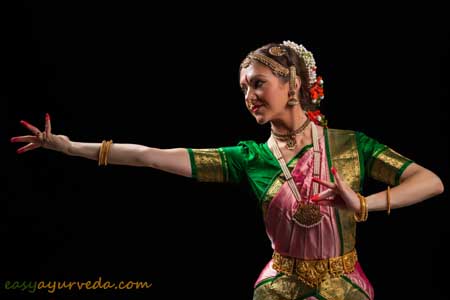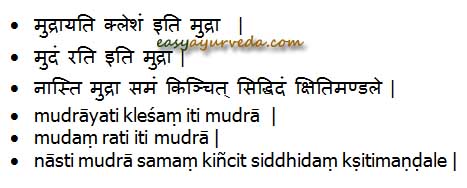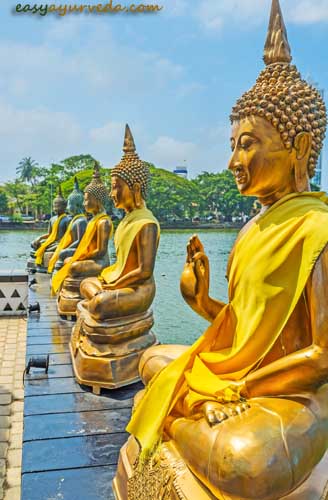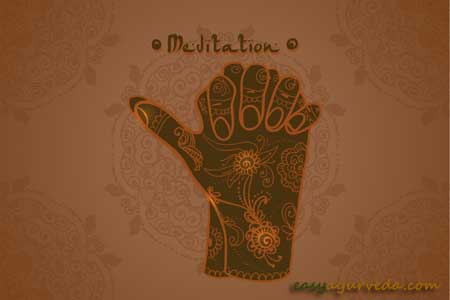Mudra – The Science Of Gesture: Benefits, Types, How To Practice

By Dr Smitha Bhat MD (Ayu)
The Sanskrit word Mudra is translated as gesture or attitude. Mudras can be described as psychic, emotional, devotional and aesthetic gestures or attitudes.
Mudra, meaning a “seal” or a “mark” is a gesture that influence the energy within the body.
Table of Contents
Word meaning
Kularnava tantra traces the word mudra to the root mud & dravay as MUDRA= MUDH (delight or pleasure) and DRAVAY (to draw forth).

“Mudra is that which removes pain and sorrow
That which brings about happiness is called as mudra
There is nothing in this world like mudra which gives success.”
Mudras are a combination of subtle physical movements which alter mood, altitude, perception and which deepen awareness and concentration. A mudra may involve the whole body in a combination of asana, pranayama, bandha and visualization techniques, or it may be a simple hand position. It is considered to be a ‘Yogaanga’- an independent branch of yoga, requiring a very subtle awareness and introduced after some proficiency has been attained in asana, pranayama and bandha, and gross blockages are removed.
Mudras are higher practices which lead to awakening of the pranas, chakras and kundalini. They bestow major siddhis and psychic powers on advanced practice. Before attempting the practice of mudra, practical instruction from a guru is always considered to be a necessary requisite. There are references of various Mudras in the field of Indian mythology, history as well as in classical dance form.
Read related: Yoga: Introduction, History, Definition, Shat Karma, Benefits
Mudra in Hindu culture
The spiritual meaning of the mudras found its perfect expression in Ancient Indian history. The gestures of the deities depicted in Hindu and Buddhist art symbolize their functions or evoke specific mythological occurrences.

They play a large role in Buddhism, where six mudras are very familiar in the pictorial depictions of Gautama Buddha. These are very closely related to his teachings and his life. Hatha Yoga also expresses the many states of mind, such as mourning, joy, anger, and serenity, through gestures and body positions. They realize that the reverse also applies certain gestures can positively influence the psyche. Mudras are also practiced in Tantric rituals.
Mudra in Dance Forms
Mudra specialist Ingrid Ramm-Bonwitt describes this beautifully, “The hands are the bearers of important symbols, which are still universally understood in the East today. With his or her hands, the Indian dancer expresses the life of the universe. Through its variety of interpretive possibilities, the rich symbolism of the dance’s language of gestures gains a greater significance for the mind than words could express.”

Number, classification
Number of Mudra according to various classics
Hathayoga pradipika- 10
Shiva samhita -10
Gheranda samhita- 25
Abhinaya darpana -28
Mudra Classification Based part of the body used:
- Sarvanga mudra: Whole body is involved in performing these mudras
- Hasta mudra: Only hands are involved in this.
Mudra types based on its action
- Chikitsa mudra – used in treatment
- Yoga mudra – used in practicing Yogasanasa
- Pranayama mudra
- Dhyana mudra – for meditation
- Pooja mudra – for prayer, rituals
- Adhyatmika mudra – spiritual practices
- Shat Chakra mudra
Practice of Mudras
How and when is Hasta Mudras Practiced?
The hands and fingers are positioned according to the specific techniques told in various Mudras. The pressure between the fingers should be very light and fine and hands should be relaxed.
Hasta Mudras can be done while seated, lying down, standing, and walking. Body posture should be symmetrical and centered, so that body is as relaxed and loose as possible. If you sit on a chair while doing them, your back should be straight and your feet should have good contact with the floor.
If you do them while lying down, resting on your back is naturally the most suitable position. If you stay in this position for a long period of time, put a small pillow beneath the back of your head to take the strain off the neck. To relieve your back, you can put a cushion under the hollow of the knee or thigh. It is important to remain comfortable and relaxed, for any tension will also hinder the inner flow of energy and we want something new to flow with the mudras. If you do them while walking, make sure you move in an even, calm, and rhythmic way.
If you stand while doing them, keep your legs shoulder distance apart. The knees should be relaxed, and the tips of the toes must point forward. If you have a bit more time, you can also do the mudras in a seated meditation position—this will turn them into a longer period of meditation. When you do this, take into consideration the following basic principles of meditation technique:
- Sit with an upright pelvis and a straight spinal column on a stable cushion. Both knees should be flat on the ground or at the same height (if necessary, support the lower knee with a cushion until it is at the same height as the other knee).
- Let the hands relax on the thighs.
- Let the shoulders fall back and down in a relaxed way; your chest should be open and free.
- Pull the chin back a bit, and let the neck is long and relaxed.
- Breathe in an even, slow, flowing, and gentle way.
- Never end the meditation suddenly. Always vigorously stretch your arms and legs.
Mudras and Prana
Prana, the vital force of our body gets escaped from certain parts of body. By the regular practice of mudras, it locks the prana within the body and thereby redirects the energy within and helps in awakening ‘Kundalini’. Practice of mudra helps in improving health, removes all the blockages and ultimately induces higher states of consciousness.
Scientific approach
Mudras provide a means to access and influence the unconscious reflexes and primal, instinctive habit patterns that originate in the primitive areas of brain around the brain stem. They establish a subtle, non-intellectual connection with these areas. Each mudra set up a different effect on the body, mind and prana. The aim is to create fixed, repetitive postures and gestures which can snap the practitioner out of instinctive habit patterns and establish a more refined consciousness.
Mudra and panchabhoutika tattva
Any living body is made of ‘Pancha Mahabhoota’, the five elemental forces- Fire, Air, Ether, Earth and Water.
The 5 fingertips represent these 5 elements:
The Thumb symbolizes the Fire
The Forefinger symbolizes the Wind
The Middle finger symbolizes the Ether
The Ring finger symbolizes the Earth
The Little or small finger symbolizes the Water
Hence when the mudra is practiced these elemental forces are activated and that influence the changes in the body.

Benefits of mudra
It channelizes the proper flow of prana within the body.
It improves the health.
Regular practice of certain mudras cures the diseases.
Improve the psychological well-being.
‘Natya Shastra’, the ancient Hindu treatise on the performing arts and dance, written by Bharata Muni mentions about the importance of mudra as
Yato hasta stato drishti (Where the hand is, the eyes follow),
Yato drishti stato manaha (Where the eyes go, the mind follows),
Yato manaha stato bhava (Where the mind is, there is the expression),
Yato bhava stato rasa (Where there is expression, there is mood i.e., appreciation of art).
Hence the regular practice of mudra will influence the physical, psychological entity of the individual. It helps in the health promotion and cures certain diseases. Thus the practice of mudra has a great role in the healthy longevity of an individual.
Author: Dr. Smitha Bhat
Alva’s Ayurveda Medical College,
Moodabidri, Karnataka
E mail- [email protected]










3 comments
v.r.k. Raman
Thanks. Very useful information, well presented.
v.r.k. Raman
Ranjit Sadanandan
You have provided subtle details on mudras which we cannot see in some of the popular mudra books available in India. Glory to you.
Nivya
well explained..thank you